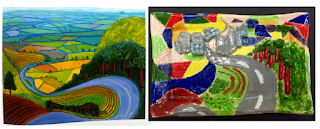Lesson Objective: Create 3-D artwork in Clay from Famous 2-D artwork explore and review cumulative learning of additive, subtractive construction and the elements and principles of art.
Project Requirements:
Sketchbook: Complete a plan of the final plate, with famous artwork in your sketchbook including:
Plan for addition and subtraction of clay
Update the work for contemporary day
Details with Measurements for final construction
Details with Measurements for final construction
Full Color Study with approval to move to final project
Final Art work:
Create a uniform dinner plate, with a famous artwork, in clay
Must have addition and subtraction
Must consider line, shape, value, color, texture, balance, unity & movement
Update the work to represent contemporary day
Glaze is applied with detail and precision
Presentation:
Famous Artist Information
Birth/Death
School
Art Movement Association
Major Exhibitions
Lasting Value of the work
Interesting information
Quote
Final meets California Art Standards:
1.8 Analyze the works of a well-known artist as to the art media selected and the effect of that selection on the artist's style.
2.1 Create original works of art of increasing complexity and skill in a variety of media that reflect their feelings and points of view.
2.2 Plan and create works of art that reflect complex ideas, such as distortion, color theory, arbitrary color, scale, expressive content, and real versus virtual.
2.4 Demonstrate in their own works of art a personal style and an advanced proficiency in communicating an idea, theme, or emotion.
2.6 Present a universal concept in a multimedia work of art that demonstrates knowledge of technology skills.
3.2 Identify contemporary artists worldwide who have achieved regional, national, or international recognition and discuss ways in which their work reflects, plays a role in, and influences present-day culture. (artist statement question)
4.1 Describe the relationship involving the art maker (artist), the making (process), the artwork (product), and the viewer.
4.3 Analyze and articulate how society influences the interpretation and message of a work of art.
5.2 Compare and contrast works of art, probing beyond the obvious and identifying psychological content found in the symbols and images.
Assessment:
Informal: Small group written critique
Formal: Artist Statement
Formal: Grading final sculpture
Modifications:
English Language Learner: Handout for project, project samples, Power point with visuals, Critique for additional understanding, Demonstration of techniques, group activities to check for understanding
Special Needs: Handout for project, project samples, Power point with visuals, Critique for additional understanding, Demonstration of techniques
Accelerated Learner: Expand on skills learned to create a unique project.
Advanced art students will be asked to increase the difficulty of their final sculpture They will also be expected incorporate more details and principles into the final project
Scaffolding adaptations:
Students will revisit Contrast, Color, Pattern, Scale, Proportion, Movement, Rhythm from the earlier learning. We will use similar visuals to refresh earlier learning. Notes on Art history, Key Vocabulary and artists will be taken throughout discussions for added understanding. Creating sketchbook plans and Constructing final sculpture will be demo started in class using guided instruction.
Key Vocabulary: Feminist Art,
Materials:
Clay
Clay Tools
Slip
Glaze
Direct Instruction
Critique:
Small Group: Judy Chicago’s Plate
Large Group: Judy Chicago’s Plate
Judy Chicago (1939- )
Born Judith Sylvia Cohen in Chicago, Illinois
American feminist artist, art educator
Received her Master of Fine Arts from UCLA in 1964.
Known for her large collaborative art installation pieces which examine the role of women in history and culture.
By the 1970s, Chicago had coined the term "feminist art"
She founded the first feminist art program in the United States.
In 1970 full-time teacher at Fresno State College
Teaching women the skills needed to express the female perspective in their work.
She planned a class that would consist only of women
She would teach students off campus to escape "the presence and the expectations of men.”
It was at this time when Chicago would coin the term "feminist art"[
Chicago's work incorporates stereotypical women's artistic skills, such as needlework, counterbalanced with stereotypical male skills such as welding and pyrotechnics.
Chicago's masterpiece is The Dinner Party, which is in the collection of the Brooklyn Museum.
Dinner Party:
First epic feminist artwork
Symbolic history of women in Western civilization.
39 place settings for mythical and historical famous women
Arranged along a triangular table
Each unique place-setting includes:
A hand-painted china plate,
Ceramic flatware and chalice
Napkin with an embroidered gold edge.
Plate, brightly-colored, elaborately styled form.
Settings are on embroidered runners, with various needlework styles.












